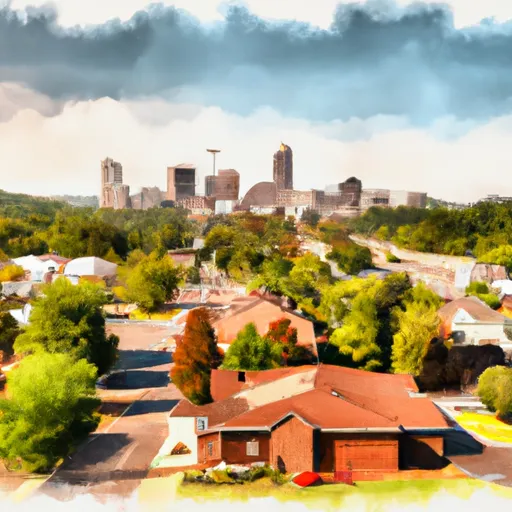-
 Snoflo Premium
Snoflo Premium
Get unlimited access to all our content
With no Ad interruptions! - Start Your Free Trial Login with existing account
Ravenscroft
Eden Index
Climate
7.6
•
Recreation
2.8
•
Community
1.8
•
Safeguard
4.5/10

Ravenscroft, Tennessee is a small town located in the Cumberland Plateau region of the state. The climate of Ravenscroft is characterized by hot and humid summers, with temperatures reaching the mid-90s (Fahrenheit), and mild winters, with temperatures averaging in the 40s. The area experiences an average annual rainfall of about 50 inches.
Ravenscroft is blessed with abundant water resources, with several rivers and creeks flowing through the region. The Caney Fork River is the largest water body in the area, providing opportunities for fishing, boating, and kayaking. The river is home to a variety of fish species, including bass, catfish, and walleye.
Outdoor enthusiasts will also find numerous hiking trails in and around Ravenscroft. The nearby Cumberland Trail offers stunning views of the surrounding mountains and forests, and is a popular destination for nature lovers. Additionally, the area is known for its rich biodiversity, with opportunities for bird watching and wildlife spotting.
Overall, Ravenscroft, Tennessee offers a favorable climate, abundant water resources, and a variety of outdoor recreation opportunities for residents and visitors to enjoy.
What is the Eden Index?
The Snoflo Eden Index serves as a comprehensive rating system for regions, evaluating their desirability through a holistic assessment of climate health, outdoor recreation opportunities, and natural disaster risk, acknowledging the profound impact of these factors on livability and well-being.
Climate Health Indicator (CHI): 7.6
Ravenscroft receives approximately
1411mm of rain per year,
with humidity levels near 84%
and air temperatures averaging around
15°C.
Ravenscroft has a plant hardyness factor of
7, meaning
plants and agriculture in this region tend to thrive during the non-winter months.
By considering the ideal temperature range, reliable water supplies, clean air, and stable seasonal rain or snowpacks, the Climate Health Indicator (CHI) underscores the significance of a healthy climate as the foundation for quality living.
A healthy climate is paramount for ensuring a high quality of life and livability in a region, fostering both physical well-being and environmental harmony. This can be characterized by ideal temperatures, reliable access to water supplies, clean air, and consistent seasonal rain or snowpacks.
Weather Forecast
Streamflow Conditions
Upper Cumberland
Area Rivers
Upper Cumberland
Snowpack Depths
Upper Cumberland
Reservoir Storage Capacity
Upper Cumberland
Groundwater Levels
Recreational Opportunity Index (ROI): 2.8
The Recreational Opportunity Index (ROI) recognizes the value of outdoor recreational options, such as parks, hiking trails, camping sites, and fishing spots, while acknowledging that climate plays a pivotal role in ensuring the comfort and consistency of these experiences.
Access to outdoor recreational opportunities, encompassing activities such as parks, hiking, camping, and fishing, is crucial for overall well-being, and the climate plays a pivotal role in enabling and enhancing these experiences, ensuring that individuals can engage in nature-based activities comfortably and consistently.
Camping Areas
| Campground | Campsites | Reservations | Toilets | Showers | Elevation |
|---|---|---|---|---|---|
| Coosa River County Park | None | 591 ft | |||
| James H Sloppy Floyd State Park | None | 720 ft | |||
| Tally Valley County Park | None | 1,117 ft | |||
| Cloudland Canyon State Park | None | 1,847 ft | |||
| Big Oak Gap Hunter Camp | 10 | 1,404 ft | |||
| De Soto State Park | 94 | 1,477 ft | |||
| Marion County Park | None | 645 ft | |||
| Pine Glen | 31 | 990 ft | |||
| Coleman Lake Rec Area | 147 | 1,182 ft | |||
| Shellmound - Nickajack Dam Reservation | None | 678 ft |
Nearby Ski Areas
Catastrophe Safeguard Index (CSI):
The Catastrophe Safeguard Index (CSI) recognizes that natural disaster risk, encompassing floods, fires, hurricanes, and tornadoes, can drastically affect safety and the overall appeal of an area.
The level of natural disaster risk in a region significantly affects safety and the overall livability, with climate change amplifying these risks by potentially increasing the frequency and intensity of events like floods, fires, hurricanes, and tornadoes, thereby posing substantial challenges to community resilience and well-being.
Community Resilience Indicator (CRI): 1.8
The Community Resilience Indicator (CRI) recognizes that education, healthcare, and socioeconomics are crucial to the well-being of a region. The CRI acknowledges the profound impact of these elements on residents' overall quality of life. By evaluating educational resources, healthcare accessibility, and economic inclusivity, the index captures the essential aspects that contribute to a thriving community, fostering resident satisfaction, equity, and social cohesion.

